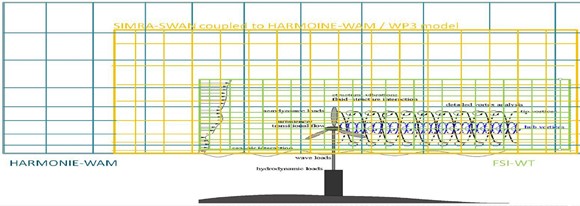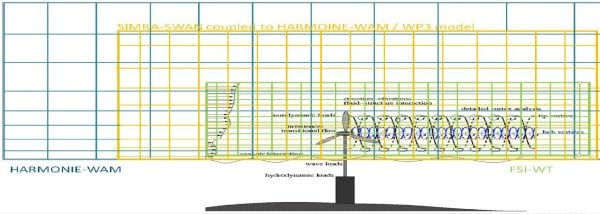Wind Modeling
|
FSI-WT
Fluid Structure Interaction for Wind Turbines

Click here to go to the project website
It is now a widely accepted fact that the future of wind energy will be offshore. The EU has already started large offshore wind power projects. China are not far behind, and the United States are seriously considering the option. At sea, compared to land, wind is both more frequent and powerful, and variability is lower. This means that offshore wind farms can quickly break even and will be a preferred option for investors. The farms are generally located far from land, and so they have little impact on the aesthetics of inhabited regions. The installation offshore is challenging and can be almost twice as expensive as a land-based deployment. However, in some ways, it is easier: the transportation of huge wind turbine blades on land is very challenging. In total, the advantages of offshore turbines are obvious and they are certainly a wiser option in the long term. Some recent studies have estimated the return on investments on offshore developments to be as high as 18%, which gives some certainty to investors, especially combined with incentives and other tax benefits. Offshore wind technology is in its infancy, and there is a need for tools to help not only in the design, but also forcasting the energy output from wind farms. At the moment, very little has been done in this direction, and the present FSI-WT project is an attempt to address some of these issues. For wind energy to be competitive against other sources (such as oil, gas and hydroelectric power), the critical factors are improved power output and reduction of installation and maintenance costs. The design of efficient and reliable wind turbines is a challenging task which requires a thorough understanding of both the aerodynamic forces induced by the wind field, as well as the structural response of the rotor and the tower. In the absence of detailed observations, numerical simulation is an invaluable way of gaining insight into these issues. Until now, integrated numerical simulation tools used by the wind energy industry apply simplified empirical or parametrized models to compute the aerodynamic forces on the blades. Typically, static lift and drag coefficients are tabulated for two-dimensional wing profiles, which are then used in three-dimensional computations to compute sectional forces along the blades. Similarly, the wake dynamics of wind turbines is usually approximated using parametrized wake models which do not resolve the viscous boundary layers around the rotor blades, but includes the effect of the wind turbine as momentum sinks in Computational Fluid Dynamics (CFD) models of the wind field using actuator disk or Blade Element Methods (BEM). These simplified models are computationally efficient, but loses important details of the flow field as well as nonlinearities in the interaction between air flow and rotor blades. Coupled Fluid-Structure Interaction (FSI) simulations are needed for accurate modeling of wind turbines, to provide input parameters, and to verify and improve parametrized models. Detailed FSI analysis will be even more important in the design of offshore wind turbines because of the extreme wind conditions at sea. To increase power production, rotor diameters are getting larger, and furture offshore wind parks might have rotor diameters as high as 150-200m. This creates new design challenges as aerodynamic instabilities causing buckling or fluttering must be taken into consideration, and new material solutions are required to produce lighter and stiffer turbine blades. Recently published FSI studies of the NREL 5MW reference offshore wind turbine blade show that blade deflections can be significant. They also show presence of high frequency oscillations in the blade twist angle, which could be important for fatigue analysis. Material failure will be even more critical for offshore wind turbines, since maintenance is more demanding due to wave interaction and extreme weather conditions. As rotor diameters and wind speeds increase, wake effects will become more severe, and the optimal design of offshore wind parks to maximize power production becomes a major challenge. In addition to reducing power output, wake effects lead to increased turbulence which can propagate fatigue failure on wind turbines in the wake. Parametrized wake vortex models seem to be unable to predict the wake effects accurately, and we require more detailed CFD studies resolving the turbine geometry, boundary layers, turbulence and structural displacements to understand the dynamics of the problem. For coupled FSI simulations of wind turbines at realistic operating conditions, accurate turbulent inflow conditions are needed to preduct structural loads and wake effects. The coupling between the turbulent atmospheric flow and the microscale simulations of a single wind turbine is non-trivial due to the large variations in spatial and temporal scales. In an offshore environment the inflow profiles are even harder to predict due to the interaction between wind and waves, as well as stratification effects. Main Objective Develop robust and efficient numerical simulation tools for coupled FSI simulation of full scale wind turbines to improve the design and increase the knowledge of wake vortex effects. Partial objectives
Results
|
| |
